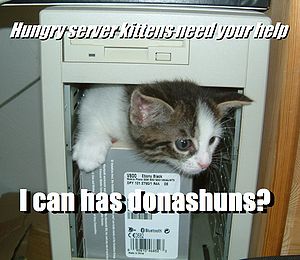
All of us are familiar with the National Public Radio model of financing. It works like this: in order to provide programming with a minimal amount of advertising, NPR affiliates make a twice-yearly appeal to their listeners for voluntary contributions, which they call “memberships.” These pitches are excruciating to listen to, partly because they last for 10 days and partly because they consist entirely of variations on a single theme: “You love our programming, and you’ve been enjoying it for free. If people like you don’t contribute, we’ll go out of business. If you want to stop feeling guilty, you’ll have to pony up.”
There are some very interesting things about this model, one of which is that the individual listener derives no external benefit from ponying up. The risk involved in failing to pony up is practically nil. Furthermore, ponying up changes nothing about the listener’s experience. Pledging a contribution doesn’t even make the pledge drive stop; pledge early or pledge late or pledge not at all, and the pledge drive will last just as long. What changes for the listener is the way he or she feels while listening to it.
It’s true, of course, that if NPR listeners were to refuse en masse to contribute to their stations’ support, at least some of those stations would in fact go out of business. But contribution decisions are made by individuals, not by crowds, and the risk to any individual listener that his or her station will go out of business due to his or her refusal to pony up is exceedingly low — far too low to act as a serious motivation to contribute. For that reason, among others, an exceedingly low number of NPR listeners do in fact voluntarily contribute. (NPR star Ira Glass, in his very funny pledge drive promos, regularly says that only 1 in 10 listeners contributes financially.)
What does this have to do with scholarly communication? Right now, not much. But recent developments suggest that it could come to have more relevance in the future.
Consider what happened some years ago with the Stanford Encyclopedia of Philosophy, a peer-reviewed, freely-available online publication that is updated on an ongoing basis and published by Stanford University. The project was begun in 1995 and then became a full-fledged online publication in 1998, attracting grant funds from the National Endowment for the Humanities (NEH) and the National Science Foundation (NSF). Its ongoing support now comes from a combination of foundation funding and voluntary contributions made by academic libraries and consortia, with matching funds from the NEH. So like NPR and its affiliate stations, the SEP subsists on a blend of public money and end-user contributions.
Now consider what happened just a couple of years ago with the arXiv. Originally developed and housed at the Los Alamos National Laboratory (LANL), the high-energy physics preprint server was for many years supported by LANL staff and a combination of NSF and Department of Energy funding. But according to Paul Ginsparg, the arXiv’s founder and developer, support for the project among senior staff at LANL was weak, and when he left for Cornell in 2001 he took the arXiv with him. For the next 10 years, the arXiv was funded jointly by the Cornell University Library and the university’s computing faculty; according to an article in Nature, the library director at the time estimated that maintaining the basic archive service would cost Cornell as little as $150,000 annually” — while also noting that the library intended to invest in structural improvements for both authors and end users.
Fast-forward to 2010, when Cornell announced a new business model for maintenance of the arXiv. According to a publicly-released budget summary, the annual cost of maintaining the service was by this point roughly $420,000, and Cornell announced that it was implementing a new system of voluntary support according to a three-tiered model under which the top 100 institutional users of the service would be asked to contribute $4,000/year, and the least-active users $2,300/year. This model was intended to keep the doors open while Cornell pursued a more permanent structural solution, and in 2012 the library announced that the Simons Foundation had given it a $60,000 planning grant “to support the development of a governance model that will guide arXiv’s transition from an exclusive initiative of Cornell University Library to a collaboratively governed, community supported resource.”
The SEP and the arXiv both represent very interesting case studies. Do they suggest anything generalizable about the future of scholarly communication?
Obviously, it’s hard to say — but I’m willing to stick my neck out this far:
First, they suggest that such a model can work, given sufficient institutional support (especially in the early going), and given strong agreement in the marketplace with the provider’s value proposition. The SEP is widely respected as a reference source, and it makes obvious sense as an online publication. The arXiv had built an exceptionally strong constituency long before anyone began asking that constituency for money. Both initiatives benefited considerably from years of comfortable incubation in an institutional setting before being nudged out into the cold world of direct-appeal fundraising.
Second, and more subtly, the experiences of the SEP and the arXiv also suggest that such a model is unlikely to become a very serious factor in the near future. How do they suggest this? By having been prominent examples of the model for years and failing to generate much in the way of imitators. If the model were intrinsically interesting, it seems to me that the successful examples of both SEP and, more recently, the arXiv would have led to the creation of more similar initiatives than they have. The fact that this model remains unusual suggests that it may not solve a problem that is widely perceived as serious by stakeholders in the research community.
There is a third issue at work here, and it’s a simple but perhaps subtle one. Budgets are tight, and that means that academic libraries (major fundraising targets for both the SEP and the arXiv) have to make very hard decisions. We don’t have the option of supporting everything that deserves our support, and we have to be ready to answer hard questions about our use of university resources. As an administrator charged with using those resources wisely, I have to be prepared to answer questions like, “What direct benefit does the university realize in exchange for the library’s expenditure of $X?” In the cases of the SEP and the arXiv, the simple answer is, “Nothing.” Our students and faculty get the same level of access regardless of our support, and there is little or no chance that our failure to donate to those initiatives will lead to their disappearance. That doesn’t mean that we shouldn’t donate (in fact, we do). It does, however, have to factor into our decisions about donating, and if current budget trends continue it very well could result in the cessation of our support.
The bottom line, I think, is that the NPR model of funding for scholarly communication bears watching — but I don’t see it becoming a major player in the landscape anytime soon.
Discussion
15 Thoughts on "The NPR Model and the Financing of Scholarly Communication"
Rick, to the best of your knowledge, do many academic libraries have a line item in their budget for voluntarily contributions for services they predict are valuable? If “sort of” yes, what would you estimate their probable % as part of the annual budget?
Bill, I’m not aware of any library that has a line item in its budget for this kind of donation. At my library, we do not. A contribution like this is likely to come from our collections budget.
Hi Rick,
Your piece today brought to mind a recent article by Duke University’s Mohamed Noor:
http://science-and-food.blogspot.co.uk/2012/06/wherefore-and-what-from-scientific.html
In it, he talks about the reasons why society donations cannot replace subscription fees/article processing charges. The money that comes in from grants is pretty well restricted in how it can be spent. A researcher can spend it on a publication charge, but not on a donation.
If the NPR model required individual researchers to make donations, we would need a significant change in the requirements from granting agencies.
The American Physical Society(APS) has experience with a variation of the NPR model in the small journal, Physical Review Special Topics-Accelerators and Beams(PRSTAB), started in 1998 and supported by a consortium of about 30 accelerator laboratories that make voluntary contributions each year. APS guarantees the journal, and makes up for the ~10-20% shortfall in contributions. The group of contributors form a small community with a strong common interest in the journal’s content. This journal was the model on which SCOAP3 was based, to form a much larger consortium of less strongly interested players to support the conversion of the major journals in high energy physics to open access. This experiment is at a crucial stage where the costs of the journals have been established with a bidding process, and voluntary contributions are being solicited from libraries and funding bodies to support the $13M budget, 50 times larger than PRSTAB. SCOAP3 has solicited support for over 5 years, and was able to get “pledges” for only 80% of the needed funds. The project is now aimed at starting in 2014 if firm 3 year commitments can be obtained before spring of next year, at which time a decision will be made as to whether to proceed. APS publishes Physical Review D, the largest journal in the SCOAP3 project, and has been willing to cooperate with this experiment, but remains skeptical that the necessary budget commitments for continuing contributions can be made by librarians in this tight fiscal climate.
There is a reason that NPR does its fundraising through its local member stations rather than through the national organization–individuals feel a stronger bond with their local station and are are more willing to donate than through the national office.
With small member organizations (like PRSTAB) there is also an unwritten social obligation to contribute and it becomes publicly awkward to those who shirks their responsibilities. You don’t get this from larger member organizations.
I don’t know about arXiv, but the announced goal of SEP is to raise an endowment that will enable it to operate indefinitely on the interest generated. So, the SEP may be using an NPR model now, but its aim is to use an endowment model ultimately. That kind of model is not so rare as you might think. E.g., a number of university presses–California, Penn State, and Texas among them–used money from NEH Challenge grants to create mini-endowments for a number of monograph series to enable them to survive over the long haul.
My guess is that there are not all that many libraries that would contribute in this way (due to budget restrictions already mentioned by Rick). If there were suddenly dozens of major publications or repositories adopting this model, the already thin dollars of libraries and funding organizations would be spread even thinner. Similarly, if there were 5 or 6 national radio organizations trying to survive on donations, they’d have a much tougher time getting donations from individuals. I think the only chance for this funding model lies in it being an exception.
Then how do you account for the success of KickStarter and other crowdsource funding initiatives? UnglueIt is one OA publisher that is using this model right now.
Sandy, your question is a non sequitur. The fact that Kickstarter is successful has no bearing on whether or not an NPR-style funding model would work for an ongoing scholarly publishing initiative, because Kickstarter operates in a completely different marketplace, and it does so by design. In fact, its rules explicitly exclude ongoing projects (such as a public radio station or a scholarly journal).
A crowdfunded service like Unglue.it may turn out to work in a limited way for books, but it’s not exactly an unqualified success at the moment.
Presses have a long history of raising funds for projects, though not for operational expenses as NPR does. I don’t see that there is a great deal of difference, Rick. It would be like getting people to donate to a particular NPR program rather than the operation as a whole. And some presses do have friends groups, as libraries do, who provide continuing support in a quasi-NPR mode.
Sandy, I don’t think anyone’s questioning whether it’s possible for organizations to raise funds for projects (such as books). What we’re discussing here is whether an NPR-style fundraising model is a promising one for scholarly communication programs (such as presses). Those do seem like pretty fundamentally different propositions to me.
The friends group model is closer to the NPR model because it is not project-specific, usually. But of course revenue from that source seldom covers more than a fraction of a press’s operating costs. However, it would be possible to operate a press on a book-by-book, crowdsource funding model, as I suggested in my essay “Back to the Future,” as indeed this was how publishing operated in the 17th and 18th centuries when book prospectuses were circulated to booksellers by publisher/printers and books were printed only when a sufficient number of guaranteed sales had been provided. The cost for each book project would cover overhead as well as direct manufacturing costs. That is, in fact, the way that presses proceed now, with each book publication plan covering its full costs.
I’ve worked for several public institutions where we were prohibited from making any “donations” to other non-profits.
While I’ve found ways around this — for example, I recently acquired “free with a $20 donation!” cookbooks by simply using an institutional credit card so I could use the bank as the vendor — I would think this kind of purchasing prohibition would definitely impede any sort of wide implementaion of the NPR model.
Interesting post and good points. I gave an NPR-styled approach some thought, once upon a time, in a freshman-meeting blog post after the 2011 AAUP: http://scrutanda.blogspot.com/2011/06/exploring-new-business-models-for_27.html
I’d say that the NPR approach does bear watching and rumination (possibly for additional reasons; namely, individuals and institutions other than libraries); but, any inspiration taken would have to be metaphoric rather than direct. The current NPR funding model grew for only partially similar reasons, over a very long period of time, and beginning a very, very long time ago …in a galaxy far, far away. For reasons mentioned above, we might see some deciding that a membership approach fits better for national or broader appeals to support the strategic needs of the many, which far outweigh the needs of the few …or the one, and through dint of their increased weight, [the needs of the many] could be deemed to hold greater and different sway with potential “members” in the scholarly community/ecosystem; if I am senior scholar, and my accountant has told me to up my charitable donations, (and if I am moved to donate to a Press/scholarly pub initiative/s), I might like to know that my $1.25 will do the most good for as many of my interests as possible. If I am a commercial vendor to scholarly presses, I might like the self-interested benefit/s of a tax deductable donation that keeps them all in business.
…and yes, that’s a Star Wars and a Star Trek reference, back-to-back.
Nutshell, as to why it is worth looking at and why it will not be directly, “as is” implementable: we are often told to look at other-than-print media for b-model examples of how they have adapted to the Internet and the digital world. However, they had a near century-long intermediary step of broadcast media, prior to the advent of the Internet (during which, our not-for-profit other-than-print media counterparts, e.g., NPR, developed their funding models, with myriad forces, national- and fiscal events impacting that development); i.e., other-than-print-media models are not starting from the same place scholarly publishing is and have not come quickly or recently to where they are. If we are to look there for guidance, and I think we can, we will have to do so with metaphor-colored glasses on.
What it needs is a b-model component or several (evolution) to make it ride high enough on the water to set sail over the chop or kick in new fins and gills to swim deep, to a compelling and sustainable depth.
The NPR model is actually quite complex. For member stations, 39% of revenues come from donations, and the rest coming from corporate sponsorship, program fees, and other sources. For NPR itself, most of the revenue comes from stations buying NPR content, then from their version of ads (sponsorships). http://www.npr.org/about/aboutnpr/publicradiofinances.html
The NPR two-tiered model doubles-down on risk diversification. Not only is the organization a confederation of different businesses, it also has two tiers of diverse revenue sources, with a strong link around programming fees around which both parts orbit — one part to get the content it will use to attract individual donors at the local level, the other part to get revenues it will use to make more content.



